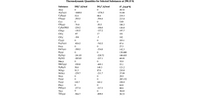
Chemistry
10th Edition
ISBN: 9781305957404
Author: Steven S. Zumdahl, Susan A. Zumdahl, Donald J. DeCoste
Publisher: Cengage Learning
expand_more
expand_more
format_list_bulleted
Question
What is the standard free energy change for the reaction below?
2 H 2O( l) → 2 H 2( g) + O 2( g)
I will attach the

Transcribed Image Text:Thermodynamic Quantities for Selected Substances at 298.15 K
Substance
DH°, kJ/mol
DG;°, kJ/mol
S°, J/mol*K
Al(s)
Al203(s)
C2H4(8)
28.32
-1669.8
-1576.5
51.00
52.4
68.4
219.3
CO2(8)
-393.5
-394.4
213.8
C(s)
CH4(8)
C2H5OH(1)
5.69
-74.6
-50.5
186.3
-239.2
-166.6
126.8
CO(g)
-110.5
-137.2
197.7
ClO2
-67
17
101
CIO3
-104
-3
162
Cl2(g)
223.1
Fe203(s)
-824.2
-742.2
87.4
27.3
Fe(s)
FeCl3(s)
H2(8)
-399.5
-334.0
142.3
130.680
H2O(g)
H20(1)
-241.83
-228.72
188.835
-285.83
-237.1
69.95
32.0
Mn(s)
MnO2(g)
-520.0
-465.1
53.1
N2H4(1)
NO(g)
50.6
149.3
121.2
91.3
87.6
210.8
NiO(s)
-239.7
-211.7
37.99
Ni(s)
O2(8)
O3(8)
29.9
205.152
142.7
163.2
238.9
64.8
Pb(s)
PbO2(s)
-277.4
-217.3
68.6
Ti(s)
TIO2(8)
30.63
-944.7
-899.5
50.33
Expert Solution
This question has been solved!
Explore an expertly crafted, step-by-step solution for a thorough understanding of key concepts.
Step by stepSolved in 2 steps with 2 images

Knowledge Booster
Learn more about
Need a deep-dive on the concept behind this application? Look no further. Learn more about this topic, chemistry and related others by exploring similar questions and additional content below.Similar questions
- N2(g) + 2O2(g)2NO2(g)Using the standard thermodynamic data in the tables linked above, calculate Grxn for this reaction at 298.15K if the pressure of each gas is 15.86 mm Hg.arrow_forwardGiven the following reaction: 9C (s) + 12H2 (g) + 3/2 O2 (g) → 3C3H7 OH (1) If the enthalpy change is -954 kJ and entropy increases: blank 1: is the reaction exothermic or endothermic? blank 2: is the reaction spontaneous or non-spontaneous?arrow_forwardCan you help me figure this out?arrow_forward
- 99+ [References] Use the References to access important values if needed for this question. Consider the reaction H₂(g) + Cl₂(g) →→→→2HCI(g) Use the standard thermodynamic data in the tables linked above. Calculate AG for this reaction at 298.15K if the pressure of HCI(g) is reduced to 13.25 mm Hg, while the pressures of H₂(g) and Cl₂(g) remain at 1 atm. ANSWER: Submit Answer B kJ/mol Try Another Version 1 item attempt remaining Previous Next 3:18 AM 11/22/2022arrow_forwardGibbs free E 1arrow_forwardEndothermic reactions are more likely to be spontaneous. O True O Falsearrow_forward
- A student determines the value of the equilibrium constant to be 6.29×104 for the following reaction.S(s,rhombic) + 2CO(g)SO2(g) + 2C(s,graphite)Based on this value of Keq:G° for this reaction is expected to be (greater, less) fill in the blank than zero.Calculate the free energy change for the reaction of 1.85 moles of S(s,rhombic) at standard conditions at 298K. G°rxn = _____ kJarrow_forwardAcetone, CH3 OCOCH3, is a fragrant liquid that is used as a solvent for lacquers, paint removers, and nail polish remover. It burns in oxygen to give carbon dioxide and water CH: COCH, (1) + 402 (9) → 3CO2(9) + 3H2O(1) If the standard free-energy change for this reaction is –1739.0 kJ/mol, what is the standard free energy of formation of acetone? Substance AG; (kJ/mol) O2 (9) Co (9) НаО() -394.4 -237.1 Standard free energy= kJ/molarrow_forwardalso, Change in Gibbs Free energy Reaction Spontaneityarrow_forward
- Calculate the standard enthalpy change for the reaction at 25 °C. Standard enthalpy of formation values can be found in this list of thermodynamic properties. MgCl₂ (s) + H₂O(1) AH;xn= V → B MgO(s) + 2 HCl(g) MacBook Air H N M 1 9 DD $10 P m kJarrow_forwardRead the descriptions of physical or chemical changes in the table below. Then decide whether the change will be spontaneous, if you can. Change During an endothermic chemical reaction, four moles of gaseous reactants are turned into two moles of gaseous products. A solid precipitates from a solution, releasing heat as it does so. A solid absorbs heat and turns to a gas. Is this change spontaneous? Yes. O No. O Can't decide with information given. O Yes. O No. O Can't decide with information given. O Yes. O No. O Can't decide with information given.arrow_forwardGibbs Free E 3arrow_forward
arrow_back_ios
arrow_forward_ios
Recommended textbooks for you
 ChemistryChemistryISBN:9781305957404Author:Steven S. Zumdahl, Susan A. Zumdahl, Donald J. DeCostePublisher:Cengage Learning
ChemistryChemistryISBN:9781305957404Author:Steven S. Zumdahl, Susan A. Zumdahl, Donald J. DeCostePublisher:Cengage Learning ChemistryChemistryISBN:9781259911156Author:Raymond Chang Dr., Jason Overby ProfessorPublisher:McGraw-Hill Education
ChemistryChemistryISBN:9781259911156Author:Raymond Chang Dr., Jason Overby ProfessorPublisher:McGraw-Hill Education Principles of Instrumental AnalysisChemistryISBN:9781305577213Author:Douglas A. Skoog, F. James Holler, Stanley R. CrouchPublisher:Cengage Learning
Principles of Instrumental AnalysisChemistryISBN:9781305577213Author:Douglas A. Skoog, F. James Holler, Stanley R. CrouchPublisher:Cengage Learning Organic ChemistryChemistryISBN:9780078021558Author:Janice Gorzynski Smith Dr.Publisher:McGraw-Hill Education
Organic ChemistryChemistryISBN:9780078021558Author:Janice Gorzynski Smith Dr.Publisher:McGraw-Hill Education Chemistry: Principles and ReactionsChemistryISBN:9781305079373Author:William L. Masterton, Cecile N. HurleyPublisher:Cengage Learning
Chemistry: Principles and ReactionsChemistryISBN:9781305079373Author:William L. Masterton, Cecile N. HurleyPublisher:Cengage Learning Elementary Principles of Chemical Processes, Bind...ChemistryISBN:9781118431221Author:Richard M. Felder, Ronald W. Rousseau, Lisa G. BullardPublisher:WILEY
Elementary Principles of Chemical Processes, Bind...ChemistryISBN:9781118431221Author:Richard M. Felder, Ronald W. Rousseau, Lisa G. BullardPublisher:WILEY

Chemistry
Chemistry
ISBN:9781305957404
Author:Steven S. Zumdahl, Susan A. Zumdahl, Donald J. DeCoste
Publisher:Cengage Learning

Chemistry
Chemistry
ISBN:9781259911156
Author:Raymond Chang Dr., Jason Overby Professor
Publisher:McGraw-Hill Education

Principles of Instrumental Analysis
Chemistry
ISBN:9781305577213
Author:Douglas A. Skoog, F. James Holler, Stanley R. Crouch
Publisher:Cengage Learning

Organic Chemistry
Chemistry
ISBN:9780078021558
Author:Janice Gorzynski Smith Dr.
Publisher:McGraw-Hill Education

Chemistry: Principles and Reactions
Chemistry
ISBN:9781305079373
Author:William L. Masterton, Cecile N. Hurley
Publisher:Cengage Learning

Elementary Principles of Chemical Processes, Bind...
Chemistry
ISBN:9781118431221
Author:Richard M. Felder, Ronald W. Rousseau, Lisa G. Bullard
Publisher:WILEY